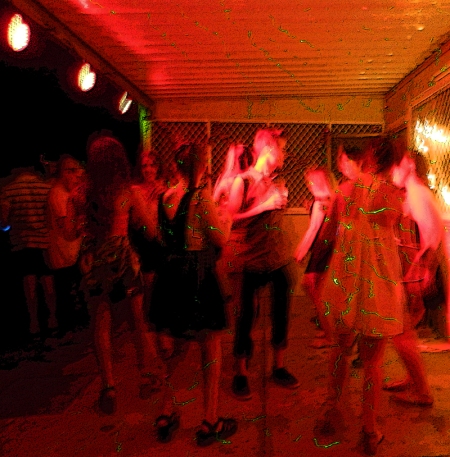
My favourite guitar is my Fender VG Stratocaster, which I call ‘Freddy’. I love it for multiple reasons including the fact that it was the first decent guitar that I ever owned. Nostalgia aside I think it is still a great guitar on its own merits. Based around an American Series Stratocaster the VG was introduced in 2007 where it won “Best In Show” at NAMM but was discontinued after April Fools Day in 2009. The VG was a collaboration between Roland and Fender and featured electronic modelling to give it some unique features or at least unique at the time. Two extra knobs were included; The T knob (Tuning) and the M knob (Mode)

Mode :
- Normal
- Stratocaster
- Telecaster,
- Humbucking
- Acoustic
Within the guitar modelling mode I would have to say that Normal and Stratocaster are somewhat smoke and mirrors. Normal isn’t really a feature it is…well, normal and in case Fender don’t realise it you are actually playing on a Stratocaster (you could play around with the tone knob to achieve the same results). Telecaster comes under the same umbrella and as I own a Tele I would have to say it doesn’t even come close to the real thing. For Humbucking you could read ‘Les Paul’ and I love it and use this a lot to give that warmer tone. Acoustic is also terrific and one of my favourites. Another thing about this guitar particularly with the acoustic mode is that its easy to play and there are a lot of songs that I struggle to play on a real acoustic but I can play perfectly on the VG in acoustic mode.
Tuning :
- Normal,
- Drop D,
- Open G,
- DADGAD,
- Baritone,
- 12 String.
The ability to change tunings at the drop of a switch was a major selling point for me. Drop D in case you don’t already know has the bass E string tuned down a tone (DADGBE). Now this is not hard to do in a live situation as it is, after all only one string but it’s a popular tuning and I use it a fair bit. Open G is the big attraction for me being a Keith Richards fan and is the altered tuning I use most often. The ability to throw in an G song into your set whenever you like and then revert back to standard is pretty damned cool. DADGAD or Dsus4 tuning, is a modal tuning that is very popular in Celtic music. Unfortunately I’m not much into this folk tuning but I sometimes have a crack at Led Zeppelin’s “Kashmir”. Baritone – baritone tuning is tuned lower than the guitar, but with the same relative tuning. There are variations on the theme and in this case it is based on the quart bass; the same as standard but lowered a fourth (BEADF#B). I fool around with this tuning a bit just to see what songs sound like relative to my voice. Sometimes I come up with little surprises. I also capo this tuning on the fourth fret to give me Hendrix’s Eb tuning, handy if your playing along with the records and Eb quite often suits my voice. 12 String – the option of six and twelve strings is really handy to have on board and colours your repertoire nicely all on one guitar. I have read criticisms of the sound of the two acoustic models but for my money they sound authentic and are a major plus in this guitars arsenal.
*Note; The Tuning functions don’t work if Mode is in Normal. Tuning functions are also relative, that is if you tune down to E flat, all of these tunings will transpose down a half step.
Many criticisms were cited for the guitar’s demise including price. In my opinion this was a fair cop but some of the other criticisms were somewhat unfair.
The choice of tunings has long been a bone of contention within VG forums and it must be said that there is merit to this argument. I don’t know why these tunings were chosen but a user defined system would be the ultimate guitar. Imagine being able to program your guitar to any tuning that you could think of and then switch between say half a dozen options at the flick of a switch. At the very least the inclusion of open E would have been a bonus.
The use of batteries to power the modelling system was often sprouted as an issue but having a second wire attached to the guitar cable seems to me, to be more problematic. In the owners manual the use of nickel–metal hydride batteries (Ni-MH) is recommended and is indeed the key to powering up the system for acceptable periods of time (my experience is 1 hour for normal batteries and 4 hours for rechargeable NiMh). I personally like GP ReCyko+ batteries because they were easy to identify the + ends and they worked well but interestingly my local supplier discontinued them because they said that people were having problems with them and they were replaced with the ‘eneloop’ brand. I’m looking for a new supplier. One issue I do have with the battery system is the fact that when they do run out the sound deteriorates rapidly and sounds fairly ugly at high volume levels. A second battery pack would therefore be an advantage.
Rise of the Phoenix : Roland G-5
http://www.youtube.com/watch?v=KKhGu-BPpng
The VG seems to have arisen from the ashes in the form of the G-5. Where as the original VG was MIA the G5 seems to be somewhat mongrel in that various parts are from different countries which has addressed the pricing issue from the previous version. The other change seems to be that the five way pickup switch has been pimped to enable some variations on sound colouring. In the acoustic mode the 5 way switch enables steel, nylon, resonator, electric sitar and jazz modeling from the original VG. The 5 way switch also allows both a wide range variation at the bridge and neck position for the Strat, Tele and Humbicking models. I can’t find anything majorly different from the original that would require me to upgrade to the new version but if I didn’t already own the original I would seriously consider checking it out.
At the time that I bought my VG the alternative to such a guitar was the Gibson Robot. I seriously considered the Robot but it was more expensive and since the principle was based on mechanics I thought there was too many components that could break down especially considering the poor quality of the finish. Now the VG has been resurrected the competition includes Line 6’s James Tyler Variax and that is a serious contender which addresses many of the concerns of VG critics. The Variax however isn’t a Fender and for my money that is still worth something.
http://www.youtube.com/watch?v=A4fBdFbym34&feature=related















